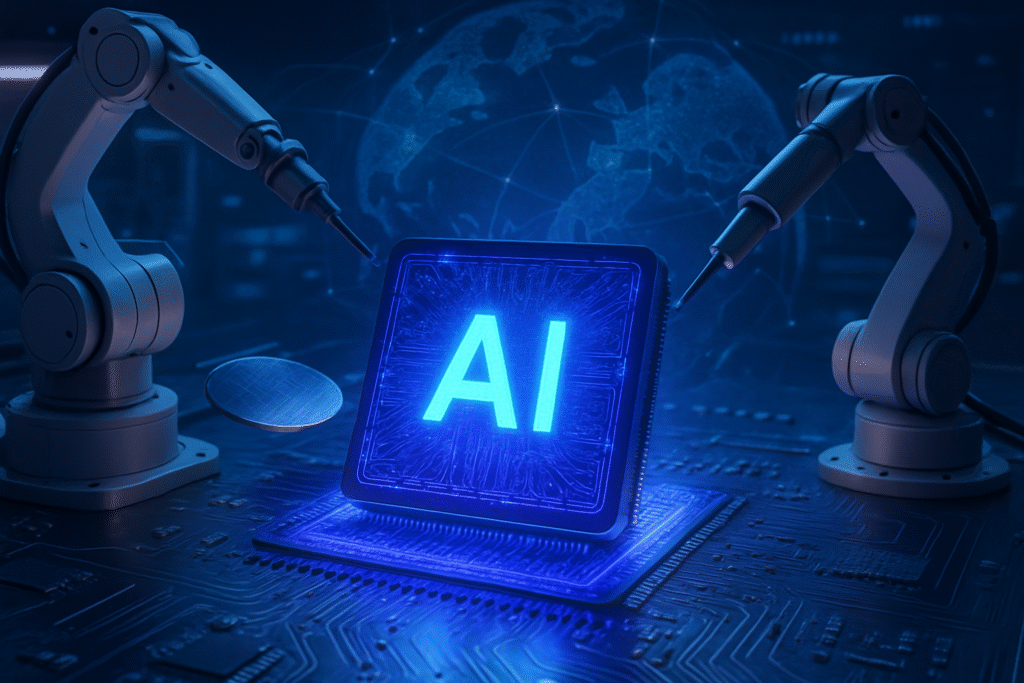Financial News
The Chip Crucible: AI’s Insatiable Demand Forges a New Semiconductor Supply Chain

The global semiconductor supply chain, a complex and often fragile network, is undergoing a profound transformation. While the widespread chip shortages that plagued industries during the pandemic have largely receded, a new, more targeted scarcity has emerged, driven by the unprecedented demands of the Artificial Intelligence (AI) supercycle. This isn't just about more chips; it's about an insatiable hunger for advanced, specialized semiconductors crucial for AI hardware, pushing manufacturing capabilities to their absolute limits and compelling the industry to adapt at an astonishing pace.
As of October 7, 2025, the semiconductor sector is poised for exponential growth, with projections hinting at an $800 billion market this year and an ambitious trajectory towards $1 trillion by 2030. This surge is predominantly fueled by AI, high-performance computing (HPC), and edge AI applications, with data centers acting as the primary engine. However, this boom is accompanied by significant structural challenges, forcing companies and governments alike to rethink established norms and build more robust, resilient systems to power the future of AI.
Building Resilience: Technical Adaptations in a Disrupted Landscape
The semiconductor industry’s journey through disruption has been a turbulent one. The COVID-19 pandemic initiated a global chip shortage impacting over 169 industries, a crisis that lingered for years. Geopolitical tensions, such as the Russia-Ukraine conflict, disrupted critical material supplies like neon gas, while natural disasters and factory fires further highlighted the fragility of a highly concentrated supply chain. These events served as a stark wake-up call, pushing the industry to pivot from a "just-in-time" to a "just-in-case" inventory model.
In response to these pervasive challenges and the escalating AI demand, the industry has initiated a multi-faceted approach to building resilience. A key strategy involves massive capacity expansion, particularly from leading foundries like Taiwan Semiconductor Manufacturing Company (TSMC) (NYSE: TSM). TSMC, for instance, is aggressively expanding its advanced packaging technologies, such as CoWoS, which are vital for integrating the complex components of AI accelerators. These efforts aim to significantly increase wafer output and bring cutting-edge processes online, though the multi-year timeline for fab construction means demand continues to outpace immediate supply. Governments have also stepped in with strategic initiatives, exemplified by the U.S. CHIPS and Science Act and the EU Chips Act. These legislative efforts allocate billions to bolster domestic semiconductor production, research, and workforce development, encouraging onshoring and "friendshoring" to reduce reliance on single regions and enhance supply chain stability.
Beyond physical infrastructure, technological innovations are playing a crucial role. The adoption of chiplet architecture, where complex integrated circuits are broken down into smaller, interconnected "chiplets," offers greater flexibility in design and sourcing, mitigating reliance on single monolithic chip designs. Furthermore, AI itself is being leveraged to improve supply chain resilience. Advanced analytics and machine learning models are enhancing demand forecasting, identifying potential disruptions from natural disasters or geopolitical events, and optimizing inventory levels in real-time. Companies like NVIDIA (NASDAQ: NVDA) have publicly acknowledged using AI to navigate supply chain challenges, demonstrating a self-reinforcing cycle where AI's demand drives supply chain innovation, and AI then helps manage that very supply chain. This holistic approach, combining governmental support, technological advancements, and strategic shifts in operational models, represents a significant departure from previous, less integrated responses to supply chain volatility.
Competitive Battlegrounds: Impact on AI Companies and Tech Giants
The ongoing semiconductor supply chain dynamics have profound implications for AI companies, tech giants, and nascent startups, creating both immense opportunities and significant competitive pressures. Companies at the forefront of AI development, particularly those driving generative AI and large language models (LLMs), are experiencing unprecedented demand for high-performance Graphics Processing Units (GPUs), specialized AI accelerators (ASICs, NPUs), and high-bandwidth memory (HBM). This targeted scarcity means that access to these cutting-edge components is not just a logistical challenge but a critical competitive differentiator.
Tech giants like Google (NASDAQ: GOOGL), Amazon (NASDAQ: AMZN), and Microsoft (NASDAQ: MSFT), heavily invested in cloud AI infrastructure, are strategically diversifying their sourcing and increasingly designing their own custom AI accelerators (e.g., Google's TPUs, Amazon's Trainium/Inferentia). This vertical integration provides greater control over their supply chains, reduces reliance on external suppliers for critical AI components, and allows for highly optimized hardware-software co-design. This trend could potentially disrupt the market dominance of traditional GPU providers by offering alternatives tailored to specific AI workloads, though the sheer scale of demand ensures a robust market for all high-performance AI chips. Startups, while agile, often face greater challenges in securing allocations of scarce advanced chips, potentially hindering their ability to scale and compete with well-resourced incumbents.
The competitive implications extend to market positioning and strategic advantages. Companies that can reliably secure or produce their own supply of advanced AI chips gain a significant edge in deploying and scaling AI services. This also influences partnerships and collaborations within the industry, as access to foundry capacity and specialized packaging becomes a key bargaining chip. The current environment is fostering an intense race to innovate in chip design and manufacturing, with billions being poured into R&D. The ability to navigate these supply chain complexities and secure critical hardware is not just about sustaining operations; it's about defining leadership in the rapidly evolving AI landscape.
Wider Significance: AI's Dependency and Geopolitical Crossroads
The challenges and opportunities within the semiconductor supply chain are not isolated industry concerns; they represent a critical juncture in the broader AI landscape and global technological trends. The dependency of advanced AI on a concentrated handful of manufacturing hubs, particularly in Taiwan, highlights significant geopolitical risks. With over 60% of advanced chips manufactured in Taiwan, and a few companies globally producing most high-performance chips, any geopolitical instability in the region could have catastrophic ripple effects across the global economy and significantly impede AI progress. This concentration has prompted a shift from pure globalization to strategic fragmentation, with nations prioritizing "tech sovereignty" and investing heavily in domestic chip production.
This strategic fragmentation, while aiming to enhance national security and supply chain resilience, also raises concerns about increased costs, potential inefficiencies, and the fragmentation of global technological standards. The significant investment required to build new fabs—tens of billions of dollars per facility—and the critical shortage of skilled labor further compound these challenges. For example, TSMC's decision to postpone a plant opening in Arizona due to labor shortages underscores the complexity of re-shoring efforts. Beyond economics and geopolitics, the environmental impact of resource-intensive manufacturing, from raw material extraction to energy consumption and e-waste, is a growing concern that the industry must address as it scales.
Comparisons to previous AI milestones reveal a fundamental difference: while earlier breakthroughs often focused on algorithmic advancements, the current AI supercycle is intrinsically tied to hardware capabilities. Without a robust and resilient semiconductor supply chain, the most innovative AI models and applications cannot be deployed at scale. This makes the current supply chain challenges not just a logistical hurdle, but a foundational constraint on the pace of AI innovation and adoption globally. The industry's ability to overcome these challenges will largely dictate the speed and direction of AI's future development, shaping economies and societies for decades to come.
The Road Ahead: Future Developments and Persistent Challenges
Looking ahead, the semiconductor industry is poised for continuous evolution, driven by the relentless demands of AI. In the near term, we can expect to see the continued aggressive expansion of fabrication capacity, particularly for advanced nodes (3nm and below) and specialized packaging technologies like CoWoS. These investments, supported by government initiatives like the CHIPS Act, aim to diversify manufacturing footprints and reduce reliance on single geographic regions. The development of more sophisticated chiplet architectures and 3D chip stacking will also gain momentum, offering pathways to higher performance and greater manufacturing flexibility by integrating diverse components from potentially different foundries.
Longer-term, the focus will shift towards even greater automation in manufacturing, leveraging AI and robotics to optimize production processes, improve yield rates, and mitigate labor shortages. Research into novel materials and alternative manufacturing techniques will intensify, seeking to reduce dependency on rare-earth elements and specialty gases, and to make the production process more sustainable. Experts predict that meeting AI-driven demand may necessitate building 20-25 additional fabs across logic, memory, and interconnect technologies by 2030, a monumental undertaking that will require sustained investment and a concerted effort to cultivate a skilled workforce. The challenges, however, remain significant: persistent targeted shortages of advanced AI chips, the escalating costs of fab construction, and the ongoing geopolitical tensions that threaten to fragment the global supply chain further.
The horizon also holds the promise of new applications and use cases. As AI hardware becomes more accessible and efficient, we can anticipate breakthroughs in edge AI, enabling intelligent devices and autonomous systems to perform complex AI tasks locally, reducing latency and reliance on cloud infrastructure. This will drive demand for even more specialized and power-efficient AI accelerators. Experts predict that the semiconductor supply chain will evolve into a more distributed, yet interconnected, network, where resilience is built through redundancy and strategic partnerships rather than singular points of failure. The journey will be complex, but the imperative to power the AI revolution ensures that innovation and adaptation will remain at the forefront of the semiconductor industry's agenda.
A Resilient Future: Wrapping Up the AI-Driven Semiconductor Transformation
The ongoing transformation of the semiconductor supply chain, catalyzed by the AI supercycle, represents one of the most significant industrial shifts of our time. The key takeaways underscore a fundamental pivot: from a globalized, "just-in-time" model that prioritized efficiency, to a more strategically fragmented, "just-in-case" paradigm focused on resilience and security. The targeted scarcity of advanced AI chips, particularly GPUs and HBM, has highlighted the critical dependency of AI innovation on robust hardware infrastructure, making supply chain stability a national and economic imperative.
This development marks a pivotal moment in AI history, demonstrating that the future of artificial intelligence is as much about the physical infrastructure—the chips and the factories that produce them—as it is about algorithms and data. The strategic investments by governments, the aggressive capacity expansions by leading manufacturers, and the innovative technological shifts like chiplet architecture and AI-powered supply chain management are all testaments to the industry's determination to adapt. The long-term impact will likely be a more diversified and geographically distributed semiconductor ecosystem, albeit one that remains intensely competitive and capital-intensive.
In the coming weeks and months, watch for continued announcements regarding new fab constructions, particularly in regions like North America and Europe, and further developments in advanced packaging technologies. Pay close attention to how geopolitical tensions influence trade policies and investment flows in the semiconductor sector. Most importantly, observe how AI companies navigate these supply chain complexities, as their ability to secure critical hardware will directly correlate with their capacity to innovate and lead in the ever-accelerating AI race. The crucible of AI demand is forging a new, more resilient semiconductor supply chain, shaping the technological landscape for decades to come.
This content is intended for informational purposes only and represents analysis of current AI developments.
TokenRing AI delivers enterprise-grade solutions for multi-agent AI workflow orchestration, AI-powered development tools, and seamless remote collaboration platforms.
For more information, visit https://www.tokenring.ai/.
More News
View More




Recent Quotes
View More
Quotes delayed at least 20 minutes.
By accessing this page, you agree to the Privacy Policy and Terms Of Service.



